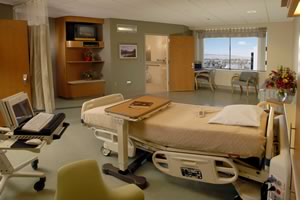

Design Matters in Health-care
Facilities
And the Pebble Project has the stats to
prove it
by Heather Livingston
Although it’s no surprise to the design community, good design does matter—and one initiative is beginning to offer proof that it matters in ways that significantly affect patient welfare. A network of health-care providers has partnered with the Center for Health Design (CHD) to provide measurable results of the impact of design on patient health and recovery, financial operations, and staff satisfaction and turnover. The mission of the Pebble Project, a four-year-old research initiative of the CHD, is “to create a ripple effect in the health-care community by providing researched and documented examples of health-care facilities whose design has made a difference in the quality of care and financial performance.”
 According
to Derek Parker, FAIA, RIBA, senior partner at Anshen + Allen Architects,
and a member of CHD’s board of directors, between 48,000 and 94,000
Americans die of preventable deaths in hospitals every year. “Hospitals
are dangerous places,” says Parker, “and there are a number
of design issues that contribute to the problem: noise is a serious distraction,
lighting, glare, overcrowding, and too few hand-washing stations.”
Parker believes, and the Pebble Project attempts to prove, that design
can provide solutions to some of these problems. Preliminary results are
showing that evidence-based design can reduce the number of patient falls,
infections, transfers, and staff turnover. In addition, the data show
increases in patient and employee satisfaction and philanthropic giving.
According
to Derek Parker, FAIA, RIBA, senior partner at Anshen + Allen Architects,
and a member of CHD’s board of directors, between 48,000 and 94,000
Americans die of preventable deaths in hospitals every year. “Hospitals
are dangerous places,” says Parker, “and there are a number
of design issues that contribute to the problem: noise is a serious distraction,
lighting, glare, overcrowding, and too few hand-washing stations.”
Parker believes, and the Pebble Project attempts to prove, that design
can provide solutions to some of these problems. Preliminary results are
showing that evidence-based design can reduce the number of patient falls,
infections, transfers, and staff turnover. In addition, the data show
increases in patient and employee satisfaction and philanthropic giving.
Measurable results
The Center for Health Design Web site reports that Bronson Methodist Hospital
in Kalamazoo, Mich., designed by Shepley Bulfinch Richardson and Abbott,
which opened its new in- and out-patient facilities in 2000, has reduced
nosocomial infections (those that originate or occur in a hospital) by
11 percent through measures like better placement of sinks, more private
rooms, and better air inflow design; overall patient satisfaction increased
to 95.4 percent; market share has increased 6 percent; and nursing turnover
rates have fallen below 12 percent, especially significant given the nationwide
nurse-shortage crisis. “Being a partner in the Pebble Project has
allowed Bronson to develop an even greater understanding of how to create
the ideal healing environment for our patients,” enthuses Frank
J. Sardone, president and CEO of Bronson Methodist Hospital. “We
made decisions regarding our new facility because we thought it was the
right thing to do for our patients. The research from the Pebble Project
provides validation for our decisions related to our new healing environment.”
At the Barbara Ann Karmanos Cancer Institute in Detroit, an alumnus of the Pebble Project, nurse attrition fell from 23 percent to 3.8 percent; patient falls were reduced 6 percent because angled doorways, lighting, and room layout provided patients better sight lines; and patient satisfaction rose 18 percent. Most significant perhaps is the 30 percent reduction in medical errors resulting from the location of and increased space in the medication room, better organization of medical supplies and visual cues, and acoustical panels that minimize ambient noise. Dore Shephard, RN, administrative manager at the Karmanos Cancer Institute, notes, “The Pebble Project gave us an organized and systematic way to collect, analyze, interpret, critique, and present data in a concise format.”
 Methodist
Hospital/Clarian Health Partners in Indianapolis reports that since opening
its Comprehensive Cardiac Critical Care unit in 1999, patient falls have
decreased by 75 percent because of the decentralized design, which allows
better patient observation; transfers have fallen from 190 per month to
fewer than 25; and patient dissatisfaction dropped from 6 percent in 1998
to 3 percent in 2001. In addition, medical paid hours per day have decreased,
resulting in savings of an astonishing $12 million per year.
Methodist
Hospital/Clarian Health Partners in Indianapolis reports that since opening
its Comprehensive Cardiac Critical Care unit in 1999, patient falls have
decreased by 75 percent because of the decentralized design, which allows
better patient observation; transfers have fallen from 190 per month to
fewer than 25; and patient dissatisfaction dropped from 6 percent in 1998
to 3 percent in 2001. In addition, medical paid hours per day have decreased,
resulting in savings of an astonishing $12 million per year.
Pebbles united
Since embarking in 2000, the Pebble Project has expanded to include 19
partners and 2 alumni. The CHD requires each participating facility to
commit to a three-year membership at an annual cost of $25,000: a significant
amount, given that today’s health-care facilities are struggling
to stay in the black. So what do the Pebbles get for their $75,000? Pebble
Projects receive national publicity in major periodicals like the Wall
Street Journal; access to current information on evidence-based
design; consulting and technical assistance to facilitate the initiative;
access to the CHD’s board, research committee, and industry experts
through working sessions that meet three times per year; and use of select
members of CHD’s staff as consultants, including a fundraiser, research
development consultant, and marketing director.
“Being a member of the Center’s Pebble Project has been very beneficial to us,” notes Methodist Hospital’s Ann Hedrich, MSN, RN, former senior vice president, senior nurse executive, and Robert Wood Johnson Fellow. “The expert members of the CHD board provide an expanded resource for research and process development. The network between partners is extremely valuable to validate and test concepts.”
 While
the CHD ideally wants projects that are in the early stages of renovation
planning to become Pebble partners, they will accept projects that are
further along in the process. According to CHD President Debra Levin,
one of the first Pebbles, St. Alphonsus Regional Medical Center in Boise,
Idaho, was already at the design stage when they joined the project. The
St. Alphonsus team quickly studied the information available through CHD
and made use of its consultants. They even flew members of the board and
staff to the facility to review their plans. The experts at CHD were astonished
to see that the plan failed to use the site’s natural setting to
the hospital’s advantage. Situated at the foot of a mountain, the
site has extraordinary views of Boise’s foothills. The original
plan had interior rooms looking upon interior rooms, minimizing patient
privacy as well as access to the outdoors. After meeting with the CHD
experts, the St. Alphonsus team decided that they had the wrong building
and went back to the drawing board. Access to nature being a key determinant
in patient outlook, the new facility looks out upon the broad mountain
expanse and offers private rooms with an extraordinary view.
While
the CHD ideally wants projects that are in the early stages of renovation
planning to become Pebble partners, they will accept projects that are
further along in the process. According to CHD President Debra Levin,
one of the first Pebbles, St. Alphonsus Regional Medical Center in Boise,
Idaho, was already at the design stage when they joined the project. The
St. Alphonsus team quickly studied the information available through CHD
and made use of its consultants. They even flew members of the board and
staff to the facility to review their plans. The experts at CHD were astonished
to see that the plan failed to use the site’s natural setting to
the hospital’s advantage. Situated at the foot of a mountain, the
site has extraordinary views of Boise’s foothills. The original
plan had interior rooms looking upon interior rooms, minimizing patient
privacy as well as access to the outdoors. After meeting with the CHD
experts, the St. Alphonsus team decided that they had the wrong building
and went back to the drawing board. Access to nature being a key determinant
in patient outlook, the new facility looks out upon the broad mountain
expanse and offers private rooms with an extraordinary view.
The CHD has recently partnered with the Robert Wood Johnson Foundation, whose primary philanthropic interest is “to improve the health and health care of all Americans” and assist in compiling and disseminating information to the people who can affect change. Together, they are working on putting together a summit in June that will present information to the national press and major players in the health-care world like Blue Cross/Blue Shield, Unicare, and Clarian Health Partners. In addition, they are hoping to present their findings in a congressional briefing as an attempt to change current regulations and induce systemic change in the health-care system.
Copyright 2004 The American Institute of Architects.
All rights reserved. Home Page ![]()
![]()
 |
||
| For more
information on the Pebble Project, visit their Web site. For more information on the Center for Health Design, visit their
Web site.
|
||